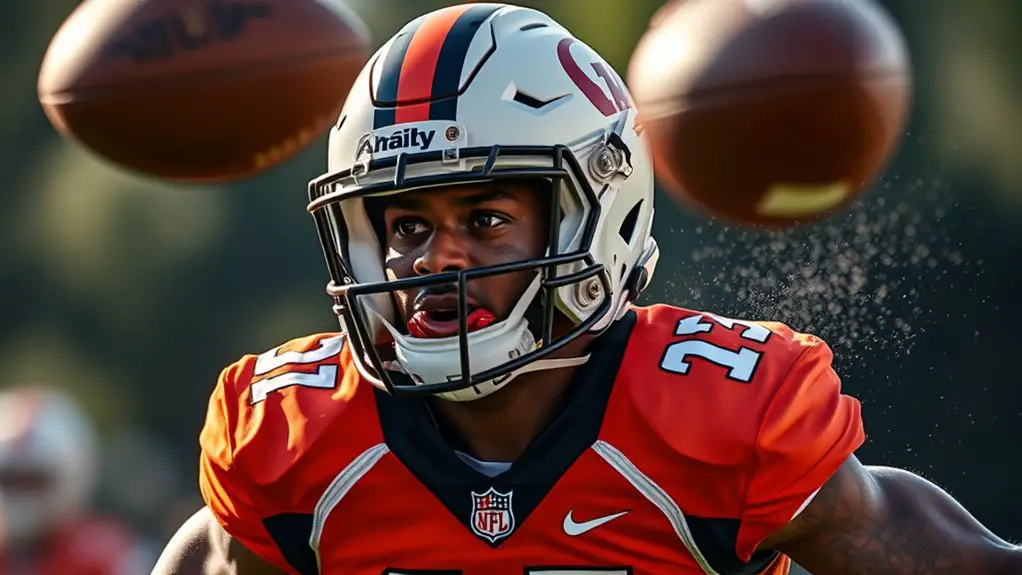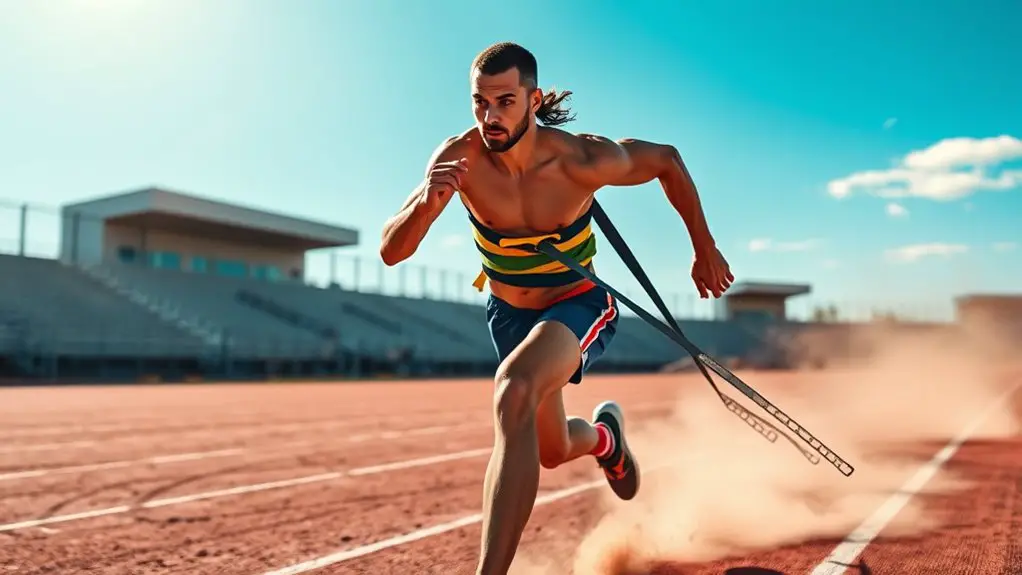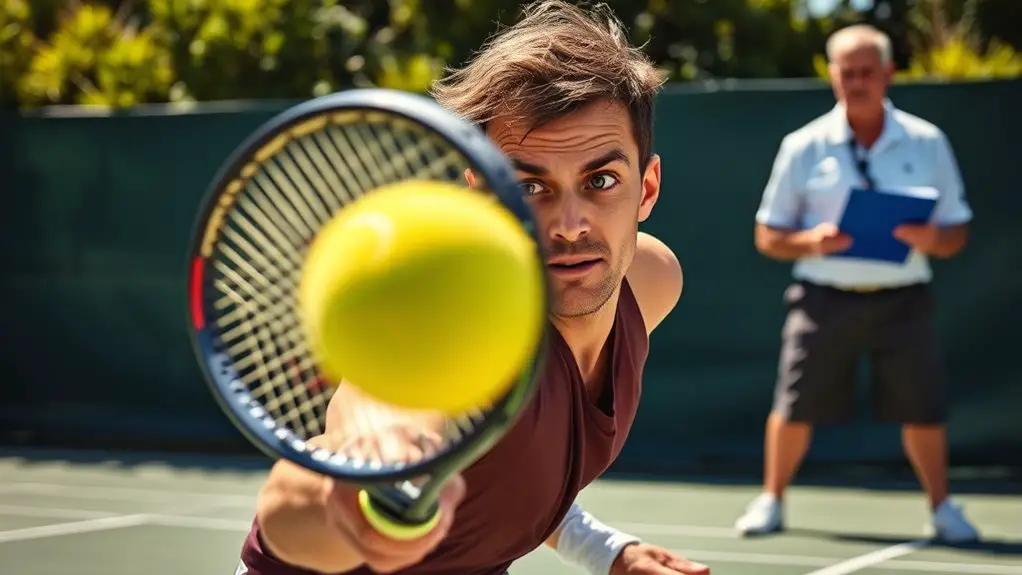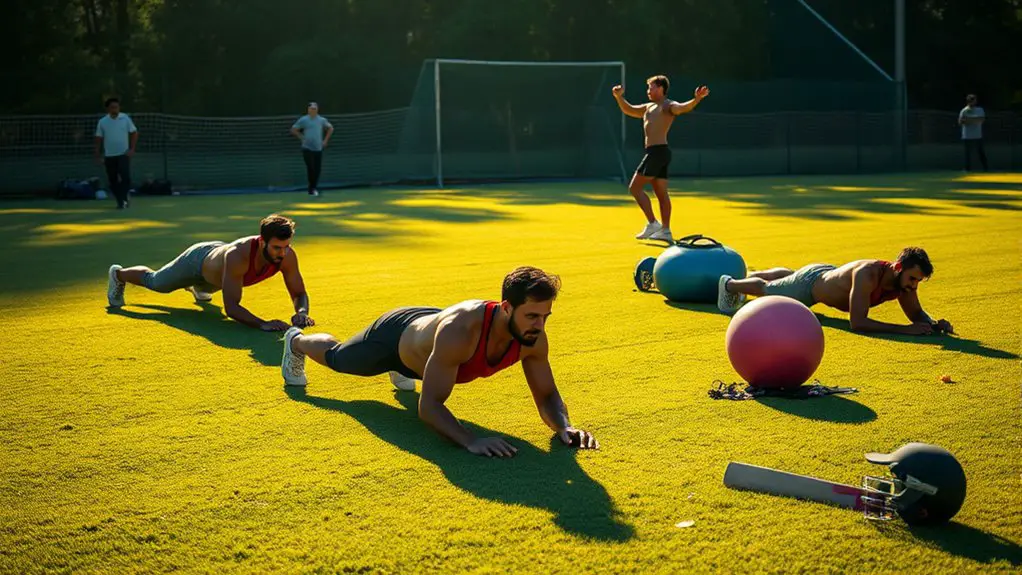To develop faster reflexes as a defensive back, focus on both physical and mental training. Incorporate agility drills, like ladder and cone exercises, to improve your quickness. Hand-eye coordination workouts and reaction ball drills will sharpen your responsiveness. Don't forget mental conditioning; visualization techniques and mindfulness practices can boost your decision-making. Mastering footwork is also essential for agility on the field. There's so much more to explore in enhancing your performance effectively.
Understanding Reflexes and Their Importance in Football
Reflexes are the backbone of a defensive back's performance on the football field. They're what allows you to react swiftly to unexpected plays, making split-second decisions that can change the game. Through effective reflex training, you can enhance your ability to respond to opponents, the ball, and evolving situations on the field. This training isn't just about physical drills; it also involves sharpening your cognitive processing skills. You'll need to read the game, anticipate movements, and make quick decisions—all of which rely on a sharp mind and quick reflexes. Integrating drills that challenge both your body and your brain can elevate your game. Focus on exercises that improve your reaction times and decision-making under pressure. By honing these abilities, you empower yourself with the freedom to take control on the field, turning your instincts into an unstoppable force against any offense. Additionally, mental alertness and awareness enhance reaction time significantly, providing you with a greater advantage during critical moments in the game.
The Role of Reaction Time in Defensive Play
In defensive play, reaction time is what sets apart great players from the rest. It's not just about speed; it's about how effectively you employ reaction strategies during the game. When a play unfolds, your ability to make instinctive movements can be the difference between a successful stop or a missed tackle. Consistent practice of these physical exercises leads to significant reflex improvements.
| Key Elements | Impact on Performance |
|---|---|
| Quick Recognition | Initiates reaction strategies |
| Body Positioning | Facilitates instinctive movements |
| Anticipation of Plays | Enhances overall reaction time |
Mental Conditioning for Enhanced Reflexes
To enhance your reflexes on the field, mental conditioning plays an essential role. By honing your mind, you can greatly improve your reaction times and decision-making under pressure. Start incorporating mental imagery into your training; visualize yourself executing plays perfectly, anticipating moves, and reacting instinctively to opponents. This technique strengthens your neural pathways, making those responses second nature.
Additionally, focus techniques are crucial. Practice mindfulness to stay present during games and drills. This helps reduce distractions, allowing you to react swiftly and confidently. You might try breathing exercises to calm your mind, enhancing your ability to process information quickly. Furthermore, integrating meditation practices can further enhance your mental conditioning, providing clarity and focus during high-pressure situations.
Agility Drills to Improve Quickness
To improve your quickness on the field, incorporating agility drills is key. Ladder drills, cone variations, and plyometric exercises can greatly enhance your reflexes and footwork. Let's explore how each of these techniques can elevate your game. Additionally, these drills are designed to improve overall agility by enhancing foot speed and coordination, crucial for defensive backs.
Ladder Drills Techniques
Ladder drills are an essential tool for any defensive back looking to enhance their quickness and agility on the field. By focusing on ladder footwork, you'll develop the explosive movements necessary for those split-second decisions. Start with basic drills like the one-foot in and two-feet in, then progress to more complex agility patterns that simulate game situations. As you become comfortable, challenge yourself with lateral movements and quick changes of direction. Incorporating these drills into your training routine will not only improve your foot speed but also boost your overall coordination. Remember, the key is to maintain control while increasing your pace. So, lace up those cleats and get ready to elevate your game!
Cone Drills Variations
Cone drills are a fantastic way to sharpen your quickness and agility as a defensive back. By adjusting your cone placement, you can create various patterns that challenge your footwork and reaction time. Start with a simple zig-zag formation, then progress to more complex shapes like T-drills or L-drills to boost your drill intensity.
As you navigate these setups, focus on explosive starts and rapid changes in direction. Incorporating different speeds will keep your muscles guessing and improve overall responsiveness. Also, don't hesitate to mix in some lateral movements to mimic game situations. Remember, the more you push your limits, the quicker you'll react on the field. So, embrace the freedom of movement and let those drills refine your skills!
Plyometric Exercises Benefits
After honing your footwork with cone drills, incorporating plyometric exercises can take your agility to the next level. Plyometric training enhances your explosive strength, allowing you to react faster and move with precision on the field. Here's how it can benefit you:
- Boosts quickness and reaction time
- Increases overall power and speed
- Improves muscle coordination and efficiency
Hand-Eye Coordination Exercises
To sharpen your reflexes as a defensive back, you'll want to focus on hand-eye coordination exercises. Using reaction balls and target practice techniques can help you improve your response time and accuracy. Additionally, incorporating visualization techniques into your training can further enhance your mental readiness and overall performance on the field. Let's explore how these drills can make a significant difference in your game.
Reaction Ball Drills
Enhancing your hand-eye coordination is essential for a defensive back, and reaction ball drills offer an effective way to sharpen those reflexes. By using reaction ball techniques, you can improve your agility and responsiveness on the field. Here are a few drills to get you started:
- Wall Bounce: Throw the ball against a wall and react to its unpredictable bounce.
- Partner Toss: Have a partner toss the ball at different angles and distances to challenge your reaction time.
- Solo Drop: Drop the ball from shoulder height and catch it as quickly as possible.
Incorporating these agility reaction drills into your training routine will boost your performance, making you a more dynamic and agile defensive back. Embrace the freedom to move faster and react quicker!
Target Practice Techniques
Building on the foundation laid by reaction ball drills, target practice techniques can further sharpen your hand-eye coordination as a defensive back. Start by setting up targets at varying distances, focusing on target acquisition to enhance your ability to quickly locate and engage your objectives. Use a lightweight ball for precision shooting exercises, throwing it at targets while maintaining your form and balance. Incorporate drills with a partner, having them randomly call out targets to simulate game scenarios. This unpredictability will push you to react swiftly and accurately. Remember, the more you practice these exercises, the more instinctive your reactions will become during gameplay. Embrace the freedom of movement and let your skills flourish on the field.
Reaction-Based Training Tools and Equipment
When it comes to sharpening your reflexes as a defensive back, the right training tools can make all the difference. Integrating reaction training tools and reflex enhancement equipment into your routine can elevate your game beyond the basics. Here are some must-have items to evaluate:
- Reaction Balls: These unpredictable bouncing balls force you to react quickly and improve hand-eye coordination.
- Agility Ladders: These tools help enhance footwork and quickness, making it easier to shift directions when needed.
- Light-Up Training Targets: These reactive devices light up at random, challenging you to react swiftly and accurately.
Incorporating Game Situations Into Practice
To truly elevate your reflexes as a defensive back, you need to simulate game situations during practice. Game simulations can create an environment where you're forced to react instinctively, honing your skills under pressure. Incorporate drills that mimic real plays, such as one-on-one matchups or team scrimmages. This not only sharpens your timing but also enhances your situational awareness.
Try varying the scenarios: adjust the offensive formations, change the quarterback's throw, or even introduce unexpected elements like a sudden whistle. Each twist will challenge you to think on your feet and adapt quickly, which is essential during live games. Additionally, integrating agility training techniques into your practice can further enhance your reflexes and overall performance on the field.
Visualization Techniques for Anticipating Plays
Visualization techniques can be a game-changer for defensive backs looking to anticipate plays before they unfold. By harnessing mental imagery, you can enhance your ability to read the game and react faster. Here are some key strategies to incorporate into your routine:
- Picture specific game scenarios: Visualize yourself in various situations, like defending against different routes or reacting to a quarterback's movements.
- Focus on successful outcomes: Imagine executing perfect tackles or interceptions to build confidence and reinforce positive performance visualization.
- Practice regularly: Make visualization a daily habit, spending a few minutes each day to mentally rehearse plays and strategies. Additionally, integrating mindfulness meditation into your training can enhance focus and reduce anxiety, further improving your reaction time on the field.
Importance of Footwork in Defensive Maneuvers
Although many aspects contribute to a defensive back's performance, footwork stands out as a crucial element in executing effective maneuvers. Your foot placement can make or break your ability to react swiftly. By mastering the fundamentals of footwork, you set yourself up for success during critical moments on the field.
Lateral movement is key to staying agile and responsive. When you can shift your weight seamlessly, you'll find it easier to mirror the receiver's movements. Focus on maintaining a low center of gravity; this helps you pivot and accelerate quickly. Remember, every step you take should be deliberate, ensuring you're always in the best position to defend against the play.
Practicing drills that emphasize quick foot placement and lateral movement will sharpen your reflexes and enhance your overall game. As you refine your footwork, you'll gain the confidence to react instinctively when it counts the most. Additionally, proper footwork reduces the risk of sprains and strains, allowing you to perform at your best throughout the season.
Monitoring Progress and Adjusting Training Regimens
As you work on developing faster reflexes, it is essential to monitor your progress and adjust your training regimens accordingly. Keeping an eye on how you're improving helps you fine-tune your approach and maximize results. Embrace the freedom to experiment, but remember to stay disciplined in tracking your progress.
Monitoring your progress is crucial for developing faster reflexes; adjust your training to maximize results effectively.
- Use video analysis to review your drills and identify areas for improvement.
- Keep a training journal to record your workouts, noting what works and what doesn't.
- Set specific goals and adjust your regimen based on those benchmarks. Additionally, incorporating biofeedback techniques can enhance your awareness of muscle tension and heart rate, leading to improved reflexes.
Frequently Asked Questions
How Can Diet Affect My Reflexes as a Defensive Back?
Your diet plays an essential role in your reflexes. By focusing on nutrient timing, you can fuel your body for peak performance. Eating the right foods before and after training helps maintain energy levels and supports quick reactions. Don't forget hydration strategies, either; staying well-hydrated keeps your body functioning at its best and enhances your alertness. When you nourish yourself properly, you'll notice a significant boost in your reflexes and overall performance.
What Role Does Sleep Play in Reaction Time Improvement?
Did you know that just one night of poor sleep can reduce your reaction time by up to 20%? That's a staggering impact! Sleep quality is essential for improving your reflexes, as it allows your body to cycle through REM stages, where memory and coordination are enhanced. Prioritizing restful sleep not only helps you feel free and energized, but it also sharpens your mind and body, giving you the edge you need.
Are There Specific Supplements for Enhancing Reflexes?
You might wonder if specific supplements can enhance your reflexes. While there's no magic pill, incorporating reflex training and cognitive exercises can boost your reaction time. Some supplements, like caffeine or omega-3 fatty acids, can support overall brain function and focus, indirectly benefiting your reflexes. Just remember, balancing a healthy diet, proper sleep, and consistent training is key. Embrace the journey of improvement; it's all about finding what works best for you!
How Do I Manage Stress to Improve My Performance?
Managing stress is like juggling flaming swords—it's intense, but you've got this! To improve your performance, focus on stress management techniques like deep breathing and visualization. These can combat performance anxiety and help you stay calm under pressure. Set realistic goals, and don't forget to take breaks; they're essential for clarity. Remember, a relaxed mind can release your true potential, giving you that freedom to shine when it counts most!
Can Age Impact My Reflex Development as a Player?
Absolutely, age can impact your reflex development. As you age, you might experience age-related changes that slow down your reaction times. However, being younger often comes with youth advantages, like quicker recovery and faster reflexes. That said, don't let age hold you back! You can still improve your skills through training and practice, regardless of your age. Focus on your strengths and stay committed to your growth as a player.




